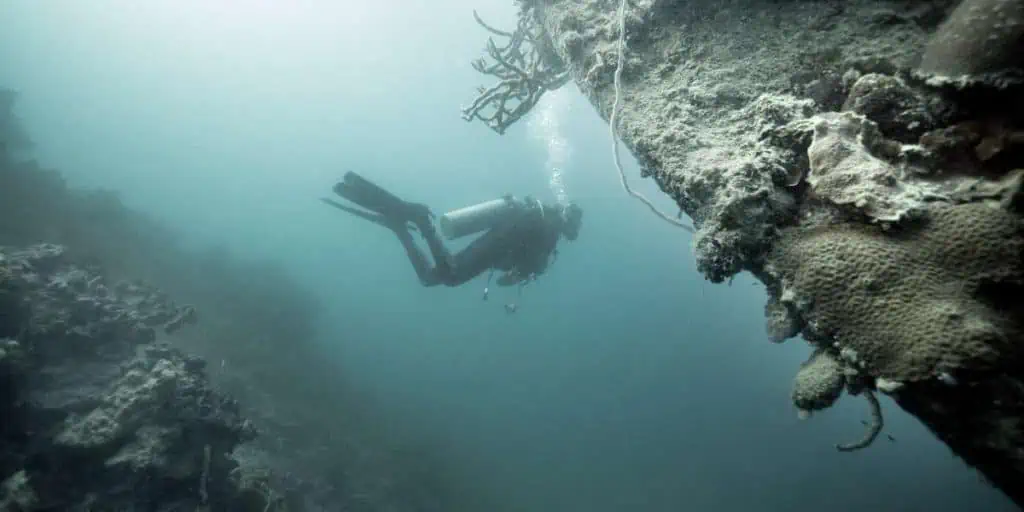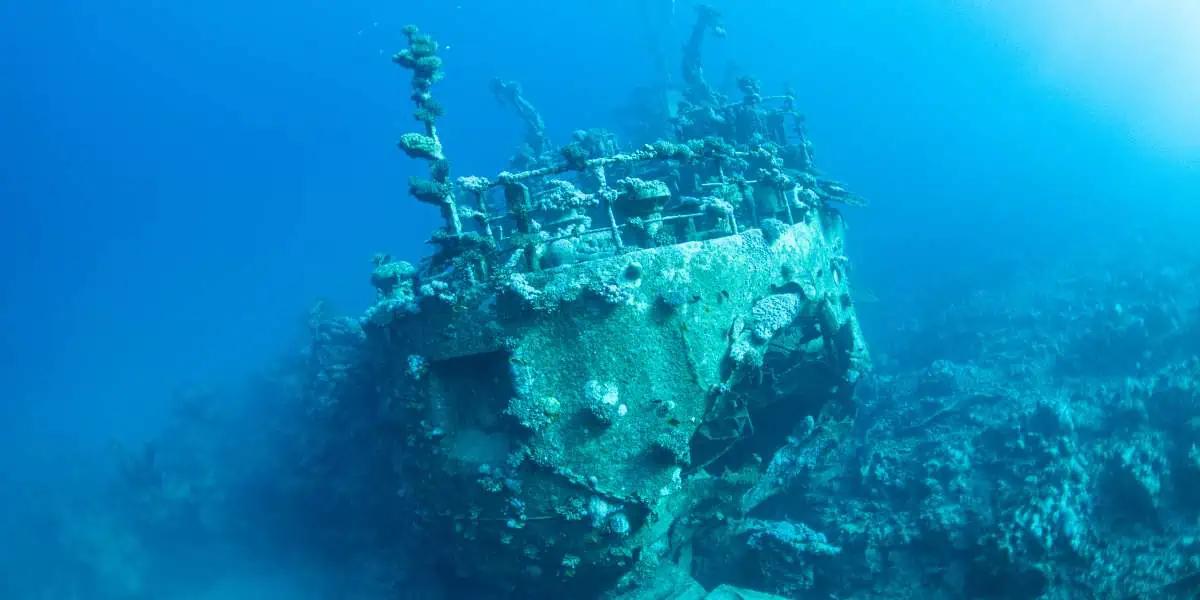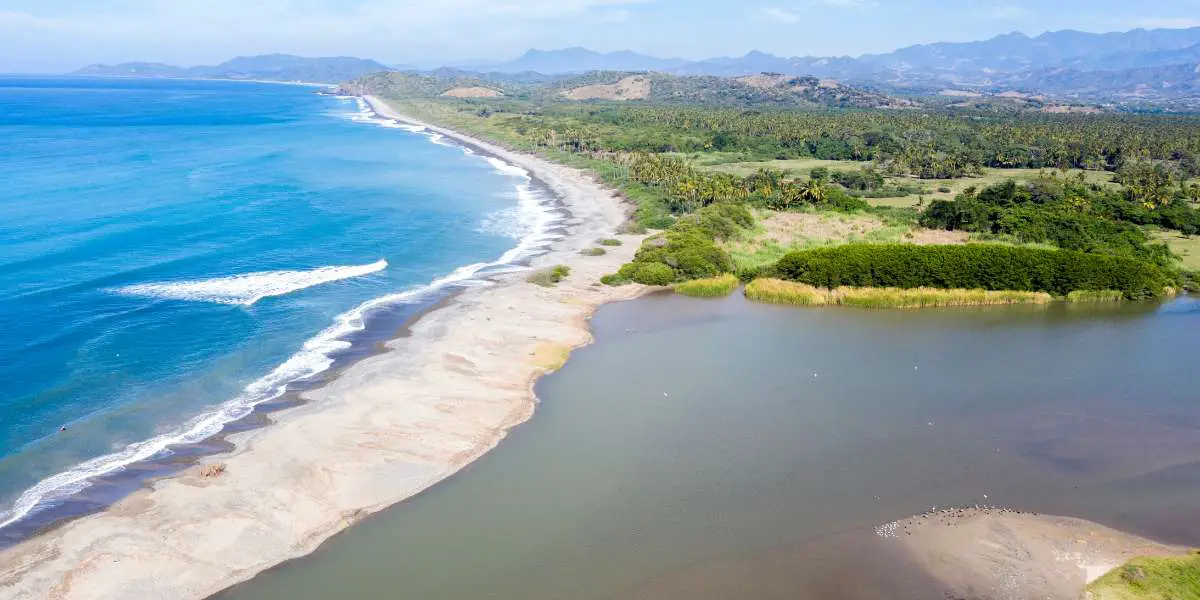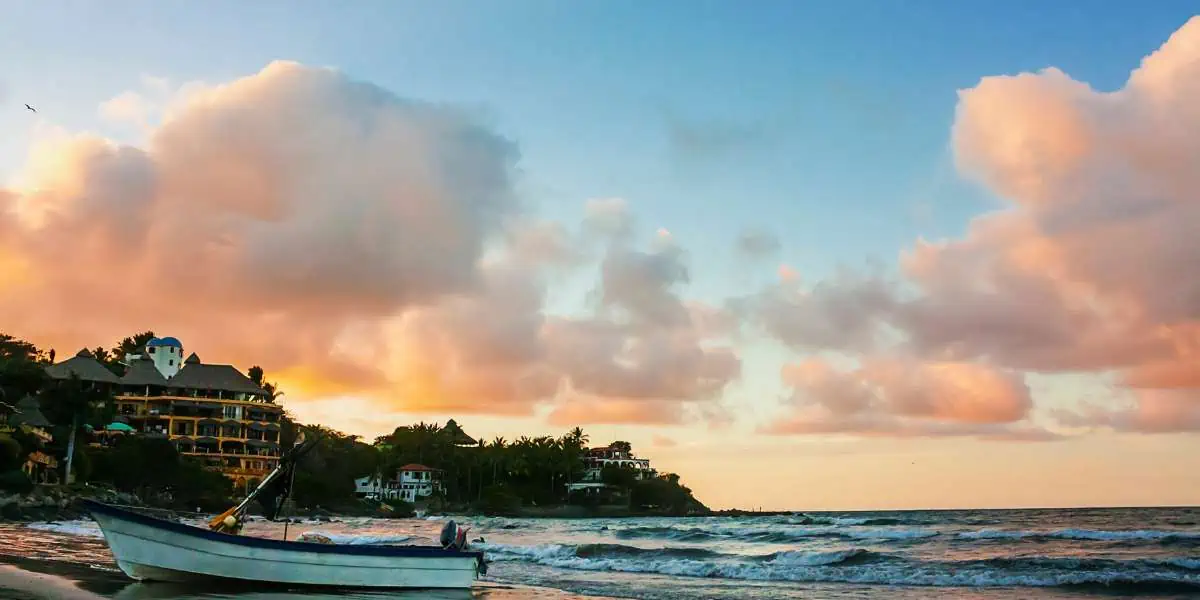Uncover the historical significance of Coron Bay and its role in World War II. Known as one of the top wreck diving destinations in the world, Coron Bay harbors some of the most iconic sunken World War II relics. These wrecks offer divers a captivating glimpse into the past while providing an aquatic habitat for stunning marine life.
Immerse yourself in the breathtaking beauty of Coron’s crystal-clear waters and diverse marine life. Coron’s idyllic natural environment provides ideal conditions for wreck diving. Warm tropical waters boast unbelievable visibility, allowing divers to fully appreciate the historical remnants from a bygone era. Vibrant coral reefs and diverse fish species have transformed these metallic graves into aquatic wonderlands.
Explore the sunken remnants of World War II Japanese ships, now teeming with vibrant coral reefs and exotic fish species. As you traverse through the deep, embark on an underwater voyage back in time. From historic gunboats and refrigeration ships, to cargo and transport vessels, discover how natural forces have reclaimed these steel structures and altered them into one of Asia’s premier wreck diving playgrounds.
The Underwater Legacy of World War II
The Sinking of the Japanese Fleet
On September 24, 1944, an epic naval and aerial bombardment took place in what would be one of the final decisive battles during World War II. The Battle of Coron Bay commenced at first light, catching the Japanese fleet resting off the eastern coast of Busuanga Island by surprise.
Over a course of a few hours, American bombers swooped in and relentlessly struck at the anchored ships with torpedoes and bombs. One after another, the Japanese ships succumbed to their damaged fate and plunged into the depths of Coron Bay. The few remaining survivors attempted to flee eastward but all were eventually conquered by the insurmountable American forces. What was left became an underwater boneyard – a memorial to those lives lost so many years ago.
Today, 14 Japanese ship and boat wrecks litter the seafloor, serving as haunting historical records of destruction and loss suffered during the war. Listed below are the known wreck sites and information detailing how they met their demise on that fateful September day.
| Wreck Site | Type of Ship | Length | Depth | Year Sunk |
|---|---|---|---|---|
| Olympia Maru | Cargo/Transport | 133m | 21-30m | 1944 |
| Okikawa Maru | Tanker | 129m | 15-23m | 1944 |
| Akitsushima | Seaplane Tender | 115m | 17-44m | 1944 |
| East Tangat Gunboat Wreck | Gunboat | 35m | 9-14m | 1944 |
| Kogyo Maru | Cargo Freighter | 118m | 22-28m | 1944 |
| Kyokuzan Maru | Cargo Ship | 149m | 15-25m | 1944 |
| Lusong Gunboat | Gunboat | 41m | 9-21m | 1944 |
| Morazan Maru | Passenger Ferry | 90m | 17-23m | 1944 |
| Irako | Refrigeration Ship | 120m | 30-43m | 1944 |
| Nanshin Maru | Cargo Ship | 89m | 20-29m | 1944 |
| Terry Kaze Maru Gunboat | Gunboat | 38m | 9-18m | 1944 |
The Fate of the Sunken Ships
Over the last 80 years beneath the sea, the wrecks have been transformed from marooned ships into magical marine habitats. While the years of saltwater corrosion and damage from typhoons have broken apart certain areas, most of the structures are still very much intact. Massive pieces like boilers, pipes, radars, engines, and weapons systems serve as a poignant reminder of their lifespans during the war.
Other areas resemble an alien world with extensive coral collages and schools of tropical fish swarming through newfound hiding spots. Descending upon these wrecks is like entering an outdoor museum where historical relics have been frozen in time, patiently waiting to share their secrets and stories.
Of the 14 known wrecks, there are a few that stand out as iconically famous. Some were the epicenters of catastrophe during the Battle of Coron Bay. Others endured turmoil after their final plunge yet continue to persist as legendary dive sites. While each wreck has its own unique identity and history, collectively they comprise a collective open-air museum for divers to learn about and reflect upon.
Preserving History Underwater
The natural elements and passing decades have certainly left their mark on the wrecks of Coron Bay. And yet surprisingly, many of the war relics are still remarkably preserved despite existing in such a harsh marine climate for so many years. One reason for this phenomenon is the ideal aquatic conditions found within the bay itself.
The combination of warm tropical water and little temperature fluctuation inhibits corrosion. Minimal currents and wave disturbance prevents excess exterior damage. This, paired with the bay’s slightly alkaline water, slows the degradation of metal structures despite long-term submersion.
While ideal environmental conditions have aided in preservation, continuous conservation efforts also help protect these unique underwater historical sites. Over 300 species of fish and over 400 species of corals call these wrecks home. Monitoring the growing ecosystem through sustainable diving practices ensures minimal negative impact from tourism.
Specified no-anchoring zones prevent chain dropping atop the wrecks which can disturb and destroy existing coral colonies. Strict legal statutes also govern the salvaging, removal, and trade of relics found on the ships as to not disturb what nature has reclaimed. Education on preserving this underwater cultural heritage for current and future generations is paramount to guarantee the longevity of Coron Bay’s beloved WWII wreck sites.
Unveiling the Hidden Gems of Coron’s Wreck Diving
Of all Coron’s Wreck Sites, a few, stand-out as must-see bucket-list underwater attractions
Olympia Maru: A Cargo Ship Transformed
The Olympia Maru is arguably Coron Bay’s most famous shipwreck site. A 133-meter Japanese cargo ship rests upright and remarkably intact in the shallow waters off Cayangan Island. The promenade deck sits at an average depth of 24 meters while the sea floor base is around 34 meters down.
The Olympia Maru met its demise on the morning of September 24, 1944, by a series of torpedo strikes amidships. Eventually, the battered vessel keeled over and settled on the sandy bottom still laden with airplanes, tanks, and a slew of munitions.
Today, only portions of the original cargo load remain. Over the years, strong waves collapsed sections of the stern decking which now hosts a wealth of sea anemones. The gunwale midship also broke during a strong typhoon, allowing sunlight to pierce the hull and facilitate growing coral inside.
The most vibrant external coral colonies crop up around the bridge and smokestack which provide firm structures for new growth. Schools of snappers and emperors inhabit the upper bridge while giant groupers and barracudas lurk in shadowy crevices around the collapsed cargo hull and catwalks.
Overall, nearly every inch of the Olympia Maru is covered in magnificent coral formations with an abundance of tropical fish occupying hiding places throughout its complicated labyrinth of rooms and passages.
Irako: A Refrigeration Ship’s Underwater Oasis
Another of Coron’s most popular wreck dives is the Irako. This 120-meter Japanese refrigeration ship turned aquarium lies just 15 minutes by boat east of Coron Town. Sunk in 1944, the 470ft vessel sits perfectly upright with the main deck at 32 meters and deeper propeller touching down at 50 meters.
Being a refrigerated ship, the Irako was built incredibly solid which has added to its durability as an artificial reef. Typhoons collapsing sections of the exterior hull made accessibility easier for divers along with letting in natural light to foster coral growth inside.
From Barracuda to batfish, turtle to tropical angelfish, the biodiversity found on the Irako is astonishing. Massive schools of snappers swarm the bridge cover while hunter groupers and Spanish mackerel patrol open areas. Inside, lionfish perch on support beams amid swaying sea fans and soft corals. Moray eels slither out from crevices and an incredible array of nudibranchs glide along the passageways adorned with sponges of all colors and shapes.
Of all Coron’s wrecks, the prolific pallet of marine life found on Irako continually captivates veteran and novice divers alike. Descending upon the relic raises appreciation for the ship’s former purpose while bearing witness to the aquatic phoenix that emerged from misfortune.
Lusong Gunboat: A Historic Battleship’s Enduring Legacy

Sunk during the same 1944 attack, the Lusong Gunboat rests between 9 to 21 meters deep upright on the sandy bottom. This 41-meter Japanese war relic has three visible turrets with the stern gun facing downward having broken off during its plummet to the seafloor.
Coral formations consume a majority of the exterior structures which provide plenty of nooks for marine life to occupy. Pufferfish frequently adorn the crow’s nest observatory while lionfish perch atop the control room roof. Inside the interior rooms, lobsters and crabs scuttle about as schools of snapper blanket the ceilings.
Perhaps the most exciting feature is the resident sea krait which inhabits the aft gun turret. Affectionately named “Lucy” by local dive guides, this venomous yet timid reptile shows no aggression resting half out of sight. Divers flock to the Lusong to hopefully catch a glimpse of this rare resident tucked away in her barrel abode.
While the Lusong Gunboat doesn’t boast as many photographic opportunities as the Irako or Olympia Maru, it certainly delivers loads of wildlife interaction rarely found across Coron’s other wrecks.
Teru Kaze Maru: A Gunboat’s Transformation into Coral Palace
Nestled between Black and Malcapi Islands rests the sunken Teru Kaze Maru gunboat. The intact exterior of this 69-foot vessel is smothered under magnificent coral growth and layers of rust accumulated over the decades.
The Teru Kaze Maru rests between 10 to 20 meters deep which allows enough light for photogenic scenes yet decent bottom times for divers. Midship railings become stairwells for giant clams while the smokestack serves as an apartment complex for blue sea stars. Sections of exterior steel collapse under the increasing weight of extensive stony coral development making room for new aquatic tenants to move in.
Schooling batfish and barracuda frequent the Teru Kaze Maru’s decks and open waters. High above, green sea turtles feed on jellyfish unphased by bubble breathing visitors. Near the sandy bottom, camouflaged scorpionfish and frogfish blend with vibrant sponges and sea squirts covering on the tires and fallen mast pole.
Gearing Up for an Unforgettable Wreck Diving Adventure
Essential Gear for Wreck Diving
To fully immerse yourself into exploring Coron’s famed wrecks, having the proper scuba gear is paramount. Visibility can range between 20 to 60+ feet depending on the season so having equipment suited for low light penetration dives ensures you don’t miss a single detail.
Most seasoned wreck divers recommend wearing darker wetsuits or exposure suits to avoid overly reflecting light in photographs and videos. Fins with spring straps also come highly suggested for easier donning and shedding in open water sessions between wreck descents.
Divers ready their kit with multiple backup torches, safety reels, and dedicated lift bags. While most wrecks have ample ambient light near their shallower levels, penetrating deeper into their inner decks and rooms can become completely dark. Proper preparation with redundant equipment minimizes potential issues when navigating confined spaces and allows you to fully illuminate vaulted chambers choking with marine growth.
Lastly, bringing relevant wreck reference materials helps divers better appreciate the history behind Coron’s famed sites. Whether that research occurs through guidebooks, websites, or even historical photos – having context transforms an average dive into a meaningful underwater history lesson.
Skill Levels and Experience
The wrecks around Coron Bay cater to all types of diving backgrounds and skill levels. Shallower sites like the Olympia Maru offer beginner-friendly experiences suitable for newly certified Open Water divers. Even snorkelers frequent the exterior portions around its top bridge just a few meters below the surface.
Yet for those seeking more advanced penetration challenges, deeper wrecks like the Irako provide multi-level layouts spanning over 40 meters in depth. Navigating the labyrinth of rooms, gangways, and cargo holds demands sharp wreck diving acumen and ideal gas/decompression planning. Even tech divers with specialized Trimix training frequent deep wrecks for their exceptional bottom times and decompression training opportunities.
Regardless of background though, wreck diving Coron’s WWII remnants heavily emphasizes responsible buddy diving protocol. Rules limit teams to no more than four people and ensure each member evenly shares a burden should issues arise. Refresher sessions on hand single use also prove useful when navigating tighter passages or dealing with silting visibility.
Professional Guidance
Lastly, while scouting dives independently remains possible for certain sites, novice and veteran divers alike recommend booking an initial orientation dive with local professionals. Establishing buoyancy control skills from the onset significantly reduces accidental structural contact and environmental disturbances.
Knowledgeable guides educate on each wreck’s unique history and layout to guarantee you don’t miss iconic attractions. They also provide key info regarding marine life behaviors and potential underwater hazards to avoid. Having an expert lead your initial descents paves the way for fully appreciating all the magic waiting to be explored across Coron’s famed WWII wreck diving paradise.
Preserving the Underwater Treasures for Future Divers
Respect and Care for Marine Life
Despite existing as lifeless dormant ships for decades, vibrant reef communities thrive across each wreck site. Schools of fish numbering in the thousands call Coron’s submerged wrecks home. Careless diving behaviors can easily disturb their aquatic residences and delicate feeding behaviors.
Conscientious divers committed to sustainable practices aim to preserve, not perturb these unique underwater habitats. Proper buoyancy control prevents accidental contact with fragile coral colonies and passing too close to camouflaged critters. Leaving macro subjects like pygmy seahorses or ornate ghost pipefish undisturbed allows them to go about their day without unnecessary stress. The same goes for reef cleaning shrimp, jawfish, and timid blue-ringed octopus tucked into crevices.
Photographing these underwater tenants is welcomed but demands patience and purpose when approaching. Adjust camera settings beforehand, frame the shot quickly, then retreat to a respectable distance. Limiting strobe use, silting sites, and eliminating flash photography aims to protect the photosensitive species. Overall, recklessness and narcissism have no place when interacting with Coron’s fragile marine residents.
Leave No Trace
Beyond focusing on minimal environmental impact from an aquatic interaction perspective, divers must adhere to strict “Leave No Trace” principles for above surface activities as well. Trash and polluting activities hold no place on small islands or aboard dive boats.
Divers pride themselves in being stewards of preserving underwater environments. What better opportunity to showcase leading by example than keeping beaches, villages, and boats debris free? Ensure to properly discard of waste including worn gear, broken equipment, food scraps, plastic packaging etc. into designated containers. If the boat lacks a rubbish bin, take it back for shore disposal.
Leave nothing but bubbles in your wake. Extend this vital concept from jumping in off the boat all the way back home once your epic diving holiday concludes. lead by example and inspire other ocean lovers about the importance of leaving no trace behind, no matter where the location.
Support Local Conservation Efforts
Myriad non-profit groups strive to protect Palawan’s precious natural resources above and below water. Organizations like Coastal Conservation Education Philippines promote reef education within local fishing villages. Their REEFolution initiative teaches villagers sustainable fishing practices to prevent naive overharvesting.
Other non-profits like LAMAVE focus on giant clam conservation to revive dwindling populations around Busuanga Island. Interns and university students learn hands-on cultivation practices during month-long work exchanges tending to LAMAVE’s underwater sea nurseries.
Lastly, rehabilitation centers work to rescue and release green sea turtles affected by habitat degradation, water pollution, and hunting practices. Their goal involves monitoring turtle restoration sights while environmental education helps local communities understand the importance of conserving these gentle marine creatures.
Eco-minded travelers ready to make a difference should consider volunteering with these impact-focused NGO’s. Lending even just a few hours contributes to a collective welfare effort facilitating meaningful progress and lowering human-triggered threats. Alternatively, visitors can reduce personal plastic usage, remain respectful towards natural sites, and provide donations supporting scientific research aimed at solving complex conservation issues.
Regardless of how you choose to contribute, supporting local sustainability efforts around Coron empowers positive change protecting the landscapes and aquatic life you’ve come to appreciate as a visitor. Keep Palawan’s environmental heritage thriving for generations to come through conscientious action benefiting its vibrant island ecosystems.
Call to Action: Embark on your own underwater adventure and discover the enchanting wreck diving sites of Coron Bay, Philippines.




